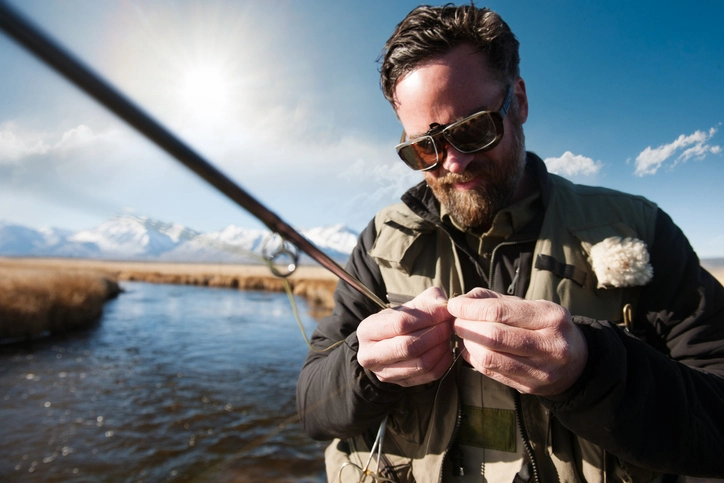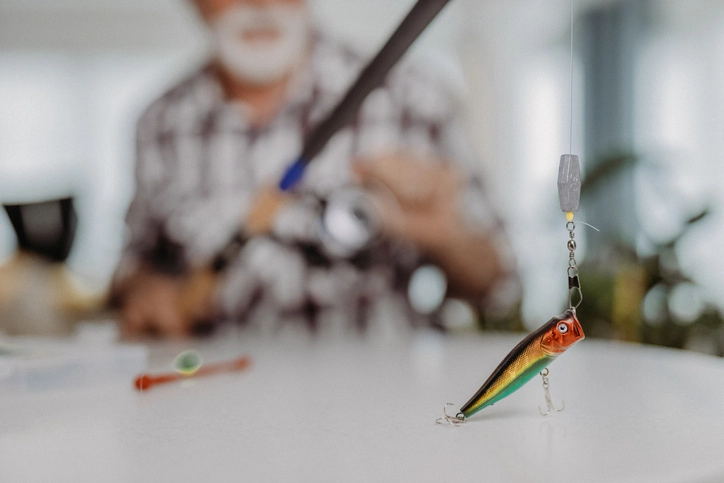“The charm of fishing is that it is the pursuit of what is elusive but attainable, a perpetual series of occasions for hope.” – John Buchan
Welcome, fellow angler! Whether you’re an avid fisherman or starting, you’ve come to the right place. In this article, I’ll walk you through the important stuff you need to know to catch walleye fish like a pro. We’ll talk about the gear you need, where to find these fish, and what bait and lures work best. So, let’s dive in and get you ready for a successful walleye fishing adventure!
Walleye fishing is a thrilling challenge and a rewarding experience. Walleye fish are sneaky and tasty, so many people love trying to catch them. If you learn some tricks and tips, you can get better at catching these fish and even snag yourself a big one to show off!
So, grab your gear, pack your patience, and dive into the exciting world of walleye fishing!
Strategies and Techniques for Catching Walleye Fish
Mastering the art of adapting to seasonal changes is paramount in pursuing walleye. In the summer, walleye change their behavior because the water gets warmer. This brings new things for people who like to fish for them. If you’re fishing in a lake, river, or pond, it’s key to understand how walleye act in the summer so you can catch them. In shallow water where it gets hotter, walleye like to hang out in cooler, deeper spots. This makes them a bit tricky to find, but catching one feels fantastic!
As the sun beats down, walleye often retreat to deeper waters during the day, seeking relief from the heat. Anglers must adjust their tactics, targeting these deeper zones where walleye congregate. The lakes and rivers in South Dakota are great spots to catch walleye in the summer. There are lots of fish and different kinds of places where they live. If you’re using fake fish or real bait, making it look like small fish can help you catch big walleye in the deep water.
Fishing for walleye in ponds can be tricky but fun. These fish like to hide near things underwater. You must be patient and gentle to catch them, using the right fake fish or natural bait. If you’re aiming to catch a big walleye during summer, it’s key to know how they act in different weather and adapt your fishing in the shiny pond water.
The Importance of Fishing Guides
Let me tell you about why fishing guides are so important. Fishing guides are like fishing experts. They know a ton about catching fish and huge walleye when it’s hard to see them. These folks have been fishing for years and know all the best spots, whether in big lakes like the Great Lakes or clean lakes in North America. They get how walleye act, so they can take you to the best places to catch them, even in tough spots like Lake Erie or North Dakota’s lakes.
Listening to their advice can help you learn helpful tips and tricks for catching walleye, like using live bait or unique lures to excite the fish. Whether fishing in a quiet stream or a big fishing contest, having a guide like Jason Mitchell can make a big difference. They can also tell you about the water temperature, which helps you figure out the best way to catch fish.
Booking a fishing guide is about more than catching more fish. It’s also about having a great time outdoors. They can teach you how to cook fish and share stories and tips from their fishing adventures. For your next outdoor adventure, whether you’re new to fishing or a pro, consider a guided walleye fishing trip. It’s a blast!
Techniques for Catching Walleye in Lakes
Let’s discuss some ways to catch walleye in lakes. One method is trolling, in which you move in your boat with your fishing line trailing behind. This helps you cover more area and find where the walleye are hanging out. Another method is jigging, in which you use a special kind of hook called a jig along with a minnow or fake bait to lure in walleye. This can work well around rocky areas or where the water gets deeper.
Another way people catch walleye is by casting their line towards the shore or underwater structures and then reeling it in. This makes it look like prey swimming, which tricks the walleye into biting. And don’t forget about using live bait like nightcrawlers or leeches – walleye love that stuff. The key is to try different methods and see what works best depending on the day and conditions when you’re fishing.
Additional Tips for a Successful Walleye Fishing Experience
- Pay attention to the weather and time of day, as these factors can influence walleye activity. Walleye are more active during low-light conditions, such as early morning and evening.
- Try using tools like fish finders to find groups of walleye or spot places underwater where they might hang out.
- Try out different colored and sized lures to see what walleye is like to bite on that day. Natural colors like silver, white, and chartreuse are often effective choices.
- Practice patience and be prepared to adapt your fishing techniques as needed. Walleye can sometimes be finicky, so be encouraged if you don’t get immediate bites.
“Understanding walleye behavior and employing the right techniques can make all the difference in your fishing success. Take the time to learn about the fish’s habitat, feeding patterns, and favorite techniques experienced anglers use.” – Bob Johnson, a professional walleye angler.
By trying out these tricks and methods, you can increase your chances of catching walleye. Before you head out, check the rules and get any permits you need for fishing. Be patient, keep at it, and learn from every fishing trip – you’ll be a pro at catching walleye before you realize it!
Gear and Equipment Recommendations for Walleye Fishing
Having the right gear and stuff for catching walleye is super important if you want to do well when fishing. Here are some valuable recommendations to optimize your gear setup:
1. Rods, Reels, and Lines: For walleye fishing in different locations, a 6 to 7-foot medium-action spinning rod is recommended. Match it with a good spinning reel with a smooth drag system. Use a fishing line that’s 6 to 8 pounds for better feel and control.
2. Bait and Lures: Walleye can be pretty selective, so it’s crucial to have a variety of bait and lures in your tackle box. When you’re out fishing for walleye, think about using live bait like minnows, leeches, or nightcrawlers on a slip bobber rig. If you’re using lures instead, give jigs, crankbaits, and soft plastics a try. Pick colors that look like what walleye like to eat in nature.
3. Other Essential Gear: In addition to fishing rods, reels, lines, and bait, every walleye angler should have a few other essential tools. First, a net is necessary to catch the fish. Second, a bag or box will help keep your gear organized. Third, sunglasses are useful for seeing better in the water. Finally, a good fish finder is a must-have to locate where the walleye are hanging out.
Getting the right gear for walleye fishing sets you up for a great time on the water. Always choose season-appropriate gear and follow fishing rules to protect fish populations.
FAQ
What are some effective techniques for catching walleye fish?
Here are some good ways to catch walleye fish. One way to catch walleye is by trolling with crankbaits, which works great in big lakes like the Great Lakes or Lake Erie. Another way is jigging with soft plastics or live bait, especially for getting big walleye in deeper water. You can catch walleye in shallow water or when they’re more active by using slip bobbers with live bait like minnows or leeches.
Some people like to cast and reel in lures like spoons or jerk baits. This is a popular method among walleye anglers in North America. It’s important to change up your approach depending on the water temperature and how the walleye are acting. For example, when it’s cold, slower presentations like the Husky Jerk can be good for catching fish that are hanging out in the middle of the water.
It’s also important to know how to tie good knots for your bait or lures, especially if you’re jigging or casting. And make sure your fishing line is strong enough to handle a big walleye. After lots of practice, guys like Jason Mitchell have become good at catching walleye, whether they’re fishing in North Dakota or exploring the Great Lakes.
Where are the best walleye fishing hotspots?
The best walleye fishing hotspots can vary depending on the region. Walleyes like to hang out near things like weeds, rocks, and spots where the water gets deeper. They also head to shallow water in the spring to lay their eggs. To find the best places to catch walleye, consider checking fishing reports, chatting with local fishermen, or hiring a guide.
What gear and equipment do I need for walleye fishing?
For walleye fishing, you’ll want to use medium to medium-light rods with smooth reels. Go for a fishing line that’s about 6 to 10 pounds, depending on how big the walleye are and where you’re fishing. Get some walleye-specific lures like jigs, crankbaits, and live bait rigs. Make sure you bring a good net to catch the fish, some fish grips to handle them, and a fish finder to help you locate where the walleye are hanging out.
What are the best bait and lures for walleye fishing?
The best live bait for catching walleye includes minnows, leeches, and nightcrawlers. You can also try out artificial lures like crankbaits, jigs, and soft plastics. What you use depends on stuff like the time of year, how clear the water is, and what the walleye are hungry for. Try different bait and lure combos to see what works best when you’re out fishing.
When is the best time to fish for walleye?
The best time to catch walleye is when they’re most active and hungry. This usually happens during low-light times like sunrise, sunset, or night. During early spring and fall, you can catch them in shallow water near the shore when they are more active. But remember, it can change depending on the lake and the weather.


